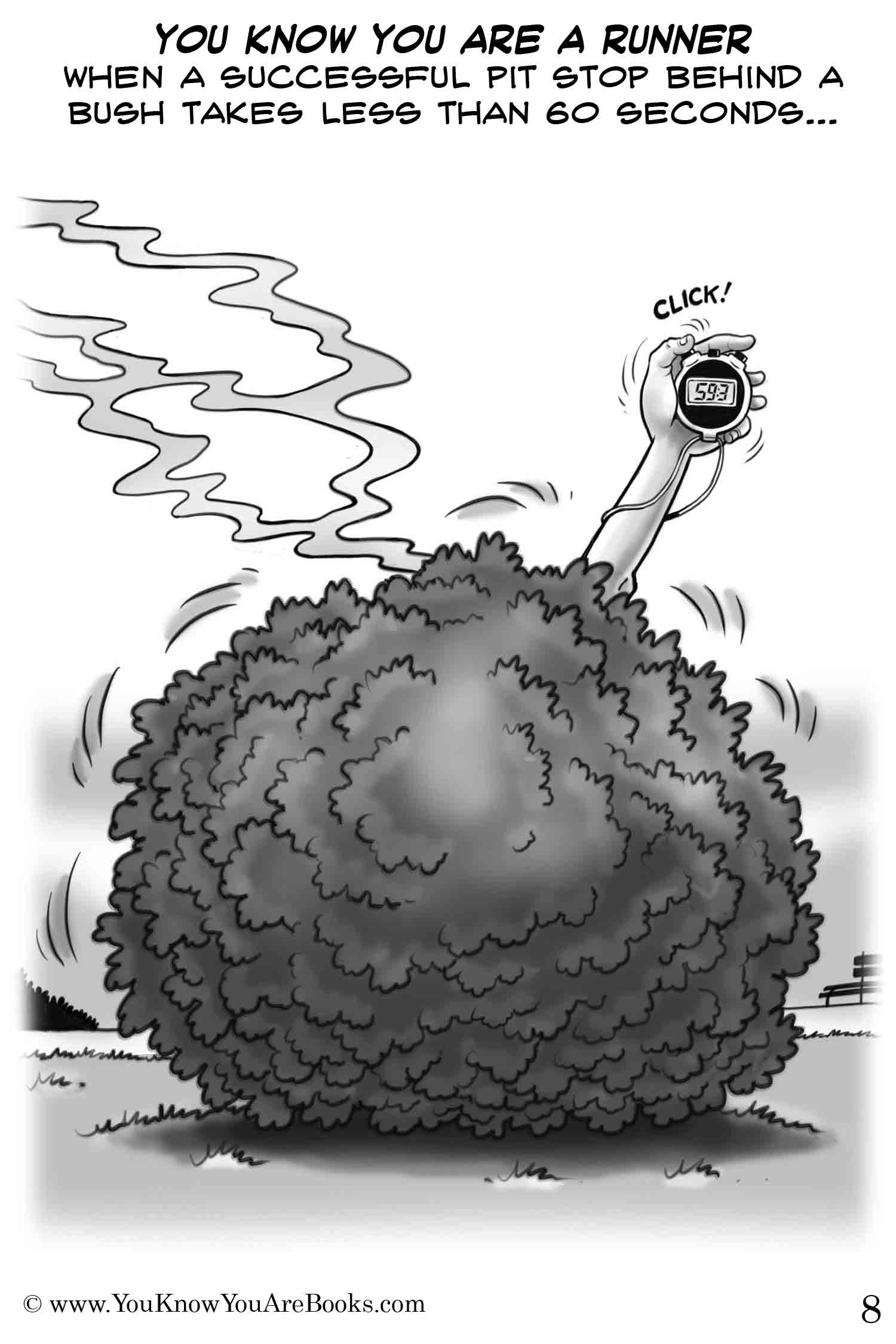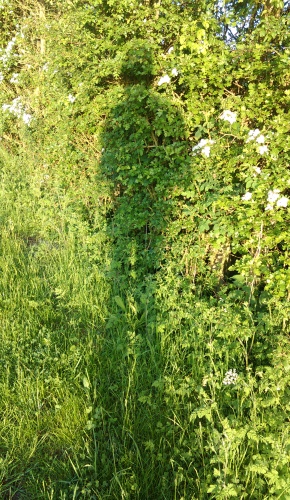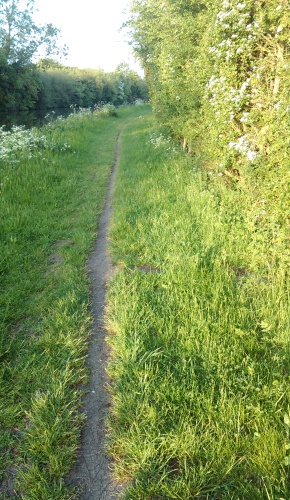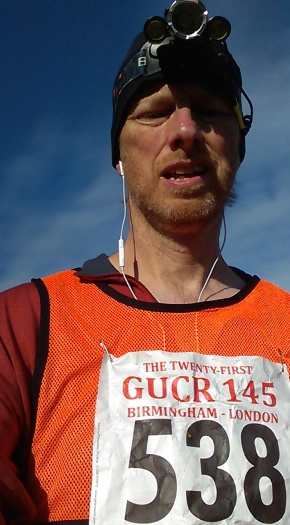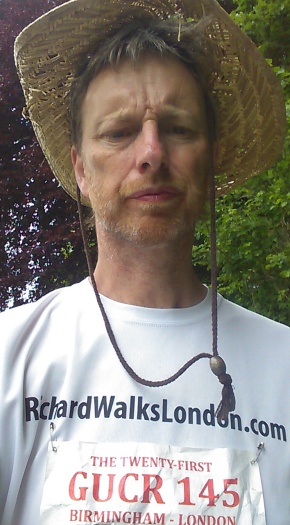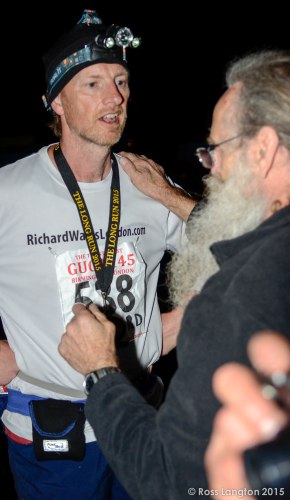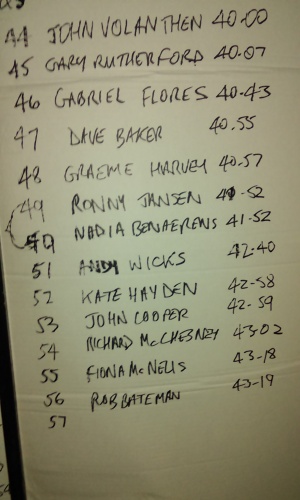Written by Richard McChesney - http://richardwalkslondon.com
The Grand Union Canal Race is an iconic ultramarathon organised by the legendary Dick Kearn and his legion of volunteers. At just £35 for supported runners and £70 for unsupported (means that the organisers feed you during the race as well), this is one of the best value for money races in the UK – when calculated on a £££’s per mile basis.
At 145 miles, following the Grand Union Canal from the Gas Street basin in Birmingham to Little Venice in London, this would be my longest race to date, and once again I was the only walker in a field of 105 starters.
For me, the event started when I finished work at lunchtime on Friday and caught the train from London to Birmingham. The train only takes 1 ½ hours, but it would take a lot longer to walk back – 40 hours was my thinking.
Arriving in Birmingham I checked in to my hotel and then went to the local shop to buy some last minute supplies. I had plenty of food in my bag already but purchased some more – just to be sure.

My bottles filled with UCan powder – just add water
I also took the time to lay everything out on the bed to check that I had everything I would need for the race – plenty of food, a change of shoes (just in case, but unnecessary), three head torches as whilst my two main head torches are extremely bright their batteries only last four hours, and my main nutrition supply for the weekend – 11 sachets of UCan which I poured into 11 bottles with the idea that I would collect one at each checkpoint and “just add water”. Also an assortment of other items including caffeine tablets and painkillers – both of which would come in useful on Saturday night and Sunday. I have wondered what the hotel cleaner thought when they cleaned my room on Saturday morning – with empty caffeine and painkiller boxes in the rubbish bin as well as some spilt white (UCan) powder on the bathroom cabinet.
Once I had sorted all my race kit and was sure that I hadn’t forgotten anything I headed up to the Travelodge in Broad Street for registration and then to the pub next door to meet some other competitors and have dinner before an early night. These days I seem to sleep well the night before a race and this was no exception. In bed by 9:30pm (the earliest I had been to bed all week) and asleep within minutes, but it wasn’t long before I woke with cramp in my left calf muscle! I hadn’t had cramp when sleeping for a long time. Why tonight?
Anyway, I lay in bed for a few moments trying to stretch out the cramp, and thinking that my alarm would probably go off shortly. I had had a good sleep and felt ready to get up but on checking my phone I found that it was only 11:30pm!
The next thing I knew it was 4am and the first of three alarms I had set woke me up. My biggest concern before a race is that I won’t wake up so as well as my alarms I also requested a wake-up call from hotel reception for 4:15. If I had waited for that I would still be asleep now as that call never came.
Breakfast would be my last meal sitting down until sometime on Sunday night so I made the most of it – porridge (one of those instant, just add water porridge’s that my wife has most mornings but I had never had before – first rule of racing is never try something new on race day), croissants, bananas and some pancakes. Enough to keep me going for the first few hours.
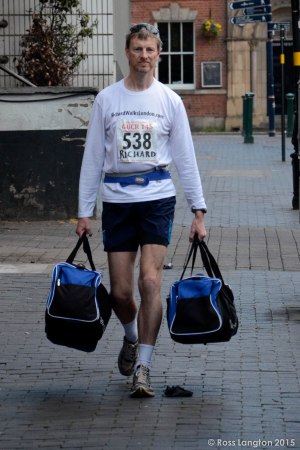
Walking to the start – Photo Ross Langton
Being an unsupported competitor I was allowed two bags of supplies which the volunteer crew would ferry from one checkpoint to another enabling me to just carry the minimum amount that I would need to get me through the few hours between each checkpoint – which were spaced between 10 and 20 miles apart with 10 checkpoints in total.
So I carried my two bags the short walk to the start in Gas Street and then waited patiently talking to some of the other competitors I had met at the pub the previous night and to others with whom I would be sharing the experience that was to come.
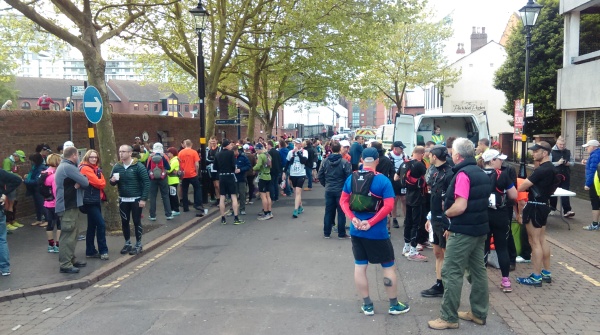
Before the start
Race Start
Just before 6am we were led down to the canal and Dick gave his final pre-race briefing (“final” because we would be off in a few minutes, but also “final” because after 21 years organising this iconic race he was handing the reigns over to someone else to take this event forward in the future), and then we were on our way.
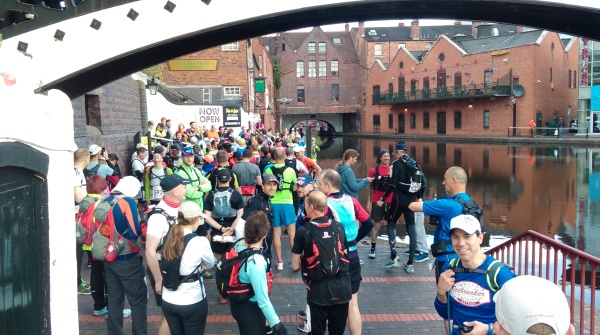
Down by the canal just before the start 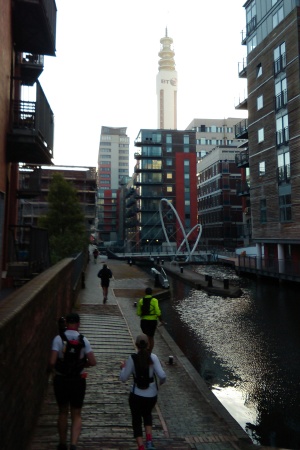
Not long after start
I deliberately started right at the back. Afterall, I was the only walker in the field so in theory I would be at the back on the field for the first part of the journey. But as with the Thames Path 100 three weeks ago, there were a few runners who wanted to run slower than I wanted to walk so it wasn’t long before I was passing runners. Not that I was walking too fast. I passed the first 5km in about 39 minutes and reached the first checkpoint (10.7 miles) in about 2 hours and 20 minutes.
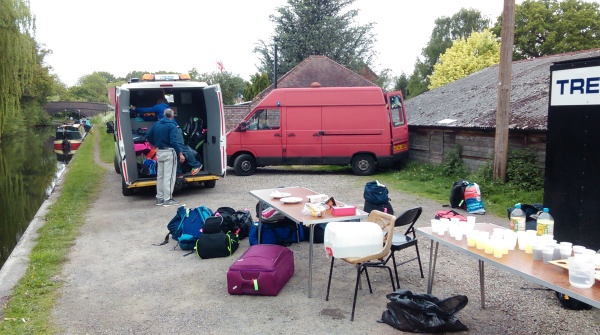
Checkpoint 1 at 10.7 miles
By that stage I had already hit my head on the low ceiling as we walked through the first tunnel, and lost my sunglasses into the canal.
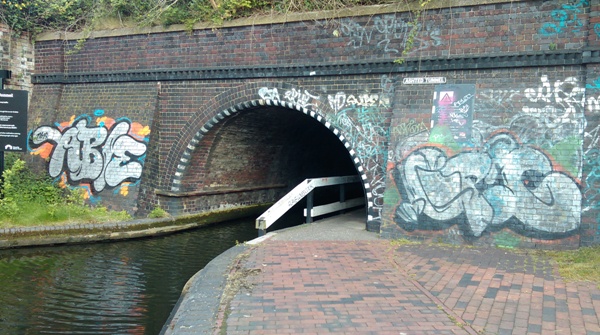
The tunnel that claimed my sunglasses
But overall the first few hours were uneventful and I just enjoyed walking in new surroundings and taking the occasional photo.
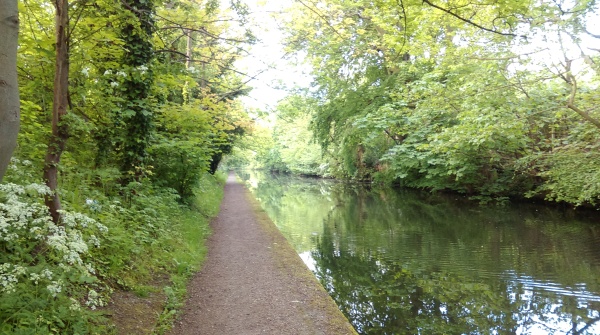
Grand Union Canal at about 7 miles into the race 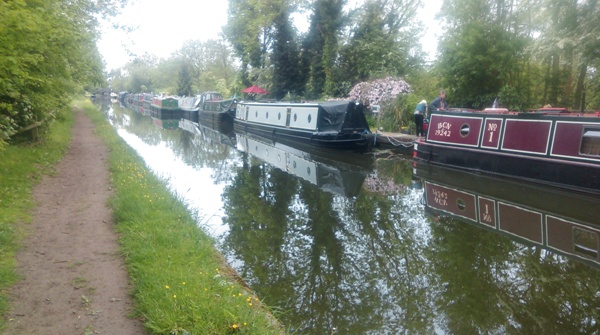
Grand Union Canal shortly after checkpoint 1 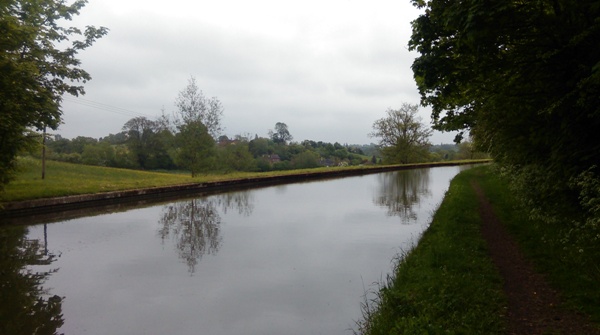
Grand Union Canal – 4 hours into the race 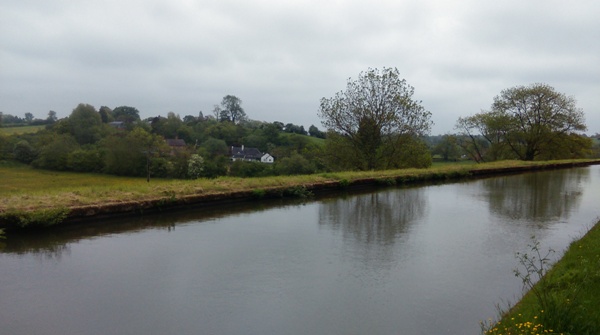
Grand Union Canal – 4 hours into the race 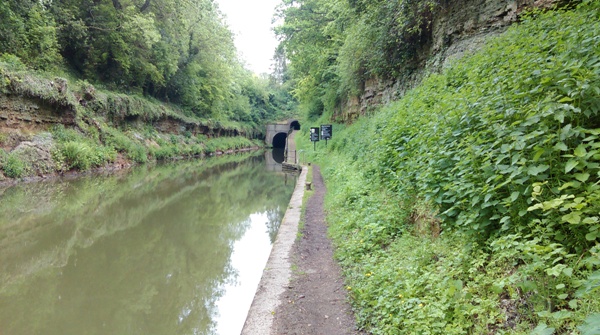
Grand Union Canal – Approaching Shrewley Tunnel (which we walked over, not through)
Unlike the first four 100 mile (and longer) walking races that I had done, this (and the Thames Path 100 three weeks ago) were point to point races and as a result there wasn’t the opportunity to grab food and drink at the end of every lap like I have become used to. Checkpoint 1 was 10.7 miles into the race, checkpoint 2 at 22.5 miles and checkpoint 3 at 36 miles. And after that the distance between checkpoints ranged from 13 to 20 miles between checkpoints.
This meant that I needed a nutritional strategy. My plan was to collect enough food at each checkpoint to get me through to the next checkpoint as well as one bottle of UCan. And at the checkpoints where hot water was available I would also get some porridge or pot noodles – neither of which I had tried in a race before. What I didn’t want to do was drink any coke or consume any high sugar foods as my concern was that once I started on high sugar food/drink I would need to consume more high sugar food and drink at regular intervals throughout the remainder of the race, and I didn’t want to start down that route too early – especially as I wasn’t intending on carrying any coke between checkpoints until near the end of the race.

Lunch on Saturday – porridge, a bag of crisps, and some biscuits, fruit, etc
I ate my second porridge of the day (the first one was at breakfast before the start) in the mile or two after leaving checkpoint 3 and it wasn’t long before I remembered the rule about not trying anything new on race day.
My first bout of diarrhoea hit me at almost exactly 9 hours into the race and for the next six hours I was expelling all the food I had consumed during the day at 20 to 30 minute intervals.
Oh the joys of ultra-distance races!
So when I arrived at checkpoint 4 (53 miles) I needed some quick energy and 5 or 6 (small) cups of coke later I was feeling much better. My intention had been to cover 70 miles through to checkpoint 5 before darkness and then put on some warmer clothes and my head torch, but I was already an hour behind the schedule I had set myself and there was a strong chance that I would need my head torch before we could get to the next checkpoint. So this became my first stop in the race. We were approximately 12 hours in and because of the diarrhoea my pace had slowed dramatically (although I was still passing runners occasionally – I was up to 78th place of 105 starters) and there was a risk that if I didn’t put my warmer clothes on now, I would be cold by the time I got to the next checkpoint.
The first night
This is from my book “You Know You Are A Runner” which is available on Amazon in kindle and paperback
I had never suffered diarrhoea in a race before. In fact, usually the complete opposite. So this was a new experience for me and fortunately, because the race was on a canal trail and it was now getting dark, there were very few people around to witness my frequent stops. No need to hide behind a bush or wait until the next public toilet. Just pull over to the side of the trail, do the business, and get going again. Most stops were less than 60 seconds.
Eventually my body returned to normal and I started to enjoy the night time walk along the canal. Dick (the race organiser) had gone to a lot of effort to produce very detailed maps of the race route. Along the canal every single bridge and lock is numbered and the maps told us which bridge to cross and any other details we needed to know. In total there were about 30 bridge crossings and two sections where we moved away from the canal for a mile or so. There were also a few junctions where you needed the map to know whether to go left, right or straight ahead, and Dick’s maps were fantastic. No chance of getting lost if you followed the maps.
The only problem was that at some stage around 60 odd miles I lost my map! And a short while later I saw a runner on the other side of the canal!
Fortunately he was going in the same direction as me. At the next lock I crossed the canal to join him only to find that we were due to cross back to my original side of the canal at the bridge about 100 meters further on. The other runner, whose name I have forgotten, had just started back running again after a short break and was going faster than me. So I borrowed his map for a few moments and noted down the bridge numbers that we would need to cross between where we were and the 70 mile checkpoint, and then let him go. The maps were printed on three double-sided sheets of waterproof A4 paper and whilst we were only on page 1 of sheet 2 I assumed that I would be able to get a replacement map at the next checkpoint so wasn’t too concerned.
I arrived at checkpoint 5 (70 miles) at around 11pm – 17 hours in to the race. I felt good and found a number of runners at the checkpoint. Many had their buddy runners with them too. From 65 miles you were allowed to have a buddy runner accompany you. This can be good for two reasons – one being safety, as we were in to the night section and were running (or in my case, walking) beside a canal. And the other reason is that, as I was finding, it was very easy to lose concentration and slow down without really meaning to. I didn’t think I would need a buddy, and to be honest, the way I was feeling I don’t know that a buddy would have helped me go any faster anyway, so I hadn’t organised one.
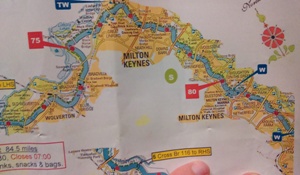
One of the maps
Back to the maps. It turned out that there weren’t any spare maps available but one of the runners gave me their map so I could take photos of it on my cellphone, and I also wrote down the bridge crossings – only four bridges to cross during the next 28 miles before we started on the last map sheet at 98 miles.
And as soon as I had noted down the bridge crossings I headed off down the canal and into the night again.
I think I may also have had my first pot noodles and grabbed some other food supplies at that checkpoint, but there was no need for any more coke. I was feeling much better.
I enjoy walking at night and made reasonable progress, arriving at checkpoint 6 (84.5 miles) at around 3am where I had another porridge. I hadn’t yet put 2 and 2 together and worked out that it was the porridge that had caused my diarrhoea yesterday.
Sunday
I was walking along on Sunday morning, 24 hours in to the race, and I suddenly realised that a) it was daylight, and b) it was sunny!
|
Me and my shadow at 6am Sunday morning |
24 hours in and it is sunny |
It was a cloudy day on Saturday but it looked like it was going to be a hot one today. And I didn’t have any sunglasses.
I arrived at the 100 mile checkpoint just before 8am (26 hours – which incidentally is my slowest of the six 100 miles I have completed) and sat down to change from my warm clothes back into my long sleeved ‘RichardWalksLondon’ shirt and one of the volunteers kindly gave me a pair of sunglasses out of his van. I also got my trustee straw hat out of my bag and grabbed some food – another porridge, some UCan, fruit, biscuits, and also a bacon and egg sandwich courtesy of the friend volunteers at checkpoint 7.
|
Almost at 100 miles |
Selfie at 31 hours |
I was 26 hours into the race. It was a beautiful sunny day. I wasn’t feeling too tired – thanks to two caffeine tablets every four hours overnight – and I only had 45 miles to go! I had also moved up to 51st place – just inside the top half of the field although I had heard that there had been plenty of DNF’s overnight.
My original target had been 36 to 40 hours. 36 hours would have meant an exceptional race and with the benefit of hindsight, knowing that only 28 runners went under 36 hours, was probably a little too ambitious. But with 14 hours to cover the last 45 miles, 40 hours was well within my reach.
But little did I know what a slog the next 45 miles was going to be. Shortly after leaving checkpoint 7 I put 2 and 2 together when I started another two hour period of diarrhoea. Obviously the porridge wasn’t such a great idea. It was also daylight now and as well as other competitors on the course there were other people, which meant I had to be a little more discrete during my 5 or 6 toilet stops between 8:30 and 10:30am.
I had also slowed right down, averaging just 5km per hour at best. This was also the longest stretch between checkpoints – 20 miles – and it wasn’t until 3pm that I arrived at checkpoint 8. Almost 7 hours to cover just 20 miles!

Am I hallucinating or is that a dinosaur? 30 hours of no sleep and I am seeing things.
For the first time in the race runners were passing me. Not that I really cared. I was just focused on moving forwards and the hours just blurred from one into another. It took me 7 hours to cover 20 miles, but it felt like only 2 or 3. I really had no concept of time.
Checkpoint 8 was the last checkpoint where we would see our bags and because it was likely that it would be dark before we finished, we were required to carry our head torches again even although it was only 3pm. I also knew that I was going so slow that I would get cold very quickly if the weather changed or it got dark, so once again I put my warmer clothes on. Pre-race I hadn’t actually thought about the possibility of the race taking me into a second night, and even now it didn’t really register with me just how long this race was taking.
Once again I grabbed some food, including my second pot noodles, and headed off along the canal. It was like I was on auto-pilot now. A very slow auto-pilot, but there wasn’t really any emotion or feeling. I knew what I had to do and I knew it was probably going to take me at least another 7 hours to do it. Just 25 miles to go.
The rest of the day time section is a blur. I remember buying an icecream, being given a slice of pizza by one of the other runners support crew, talking to a couple of runners as they went past me, and then reaching that magic signpost. The one that says “Paddington 13 miles” and points to the left.
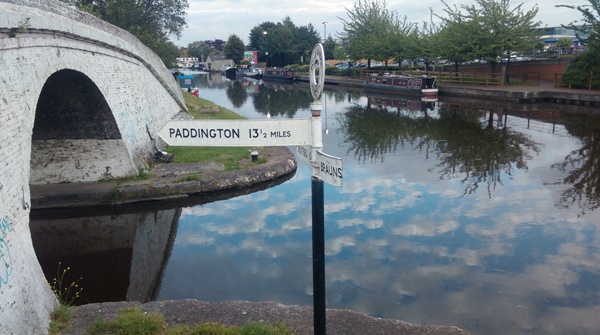
Paddington 13 miles!
No more bridge crossings. Just a half marathon to go and all along the same side of the canal.
It was 7:30pm and we had been walking for 37 ½ hours. There was just one mile to the last checkpoint. We were in London. Not long to go now.
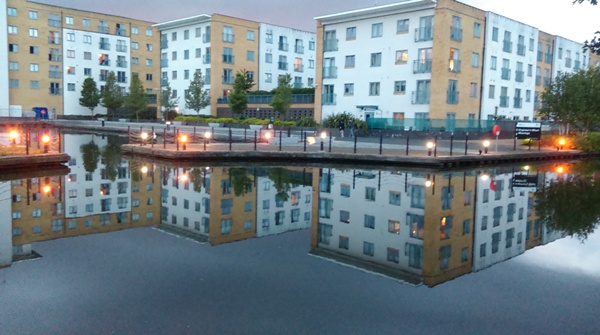
I might have been walking for 38+ hours but I can still take photos
The second night
Having read a few other race reports (see links below) I understand that this section of the canal is dirty and not necessarily the safest of places to walk. But I was a zombie now. Since early Sunday morning I had been hallucinating regularly. Everywhere I looked I had been seeing people which then turned out to be trees, rubbish bins, all sorts of objects, but not people. And with two or three hours to go I saw Gollum from Lord Of The Rings swimming in the canal under a bridge.
By this stage I was struggling to walk in a straight line and I am surprised I didn’t end up in the canal swimming with Gollum. Regularly I would catch myself as I lurched to the side instead of in the forwards direction that I was aiming for. My legs were so tired that I also found myself stopping on an increasingly regular basis. Just a quick rest where I would lean against anything that could support me.
The final stretch from checkpoint 10 to the finish was just 12 miles but was taking forever. I was down to just over 2 miles an hour (having started on Saturday morning at just under 5 miles an hour) and I was ready to quit. I had never felt this way before. I didn’t want to quit because I was in pain. In fact I was long past that pain stage. I was just so tired. And I rationalised in my mind that I had done what I set out to do. I had walked from Birmingham to London. I had seen the Grand Union Canal. I didn’t need a medal to prove it. All I really needed to do was call my wife and ask her to meet me at that bridge up ahead, and then I could sit in the car and have a sleep.
But for some reason I didn’t make that call. I kept plodding along. It was dead calm and there was no one around but me. If I wasn’t so exhausted I would have been enjoying the solitude.
A couple runners went past me and I wished them well. There was no way I could ‘race’ them. I called my wife to say that my expected finish time was now likely to be some time after midnight and I would call her again when I was about an hour from the finish.
And then suddenly I felt good again! For the first time in 15 or more hours I felt good! I have no idea what changed but I was on fire!
I rang my wife to inform her that I was probably less than an hour away from the finish. I was motoring now! At least it felt like I was, but my kilometre split times on my Garmin show that I was still doing less than 3 miles (5km) an hour.
And then just after 1am on Monday morning, having started in Birmingham 43 hours earlier at 6am on Saturday, I finished the 2015 Grand Union Canal Race – official time 43 hours and 1 minute for 54th place.
|
Receiving my finishers medal shortly after finishing – Photo Ross Langton |
The results board |
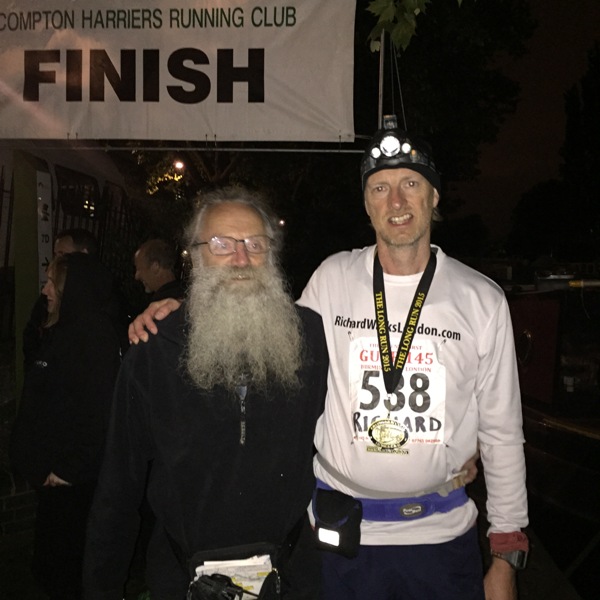
With race organiser, Dick Kearn
Some thoughts on the race
- I have just walked from Birmingham to London!

Birmingham to London via the Grand Union Canal – 145 miles
- I have just walked 145 miles or 233km – my longest ever walk!
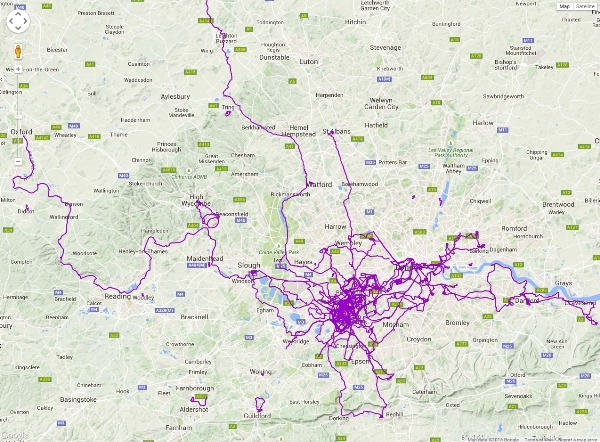
Another line added to my ever-growing map
- I passed 200km in 34 hours and 55 minutes which is faster than the official New Zealand record for walking 200km. Unfortunately this race doesn’t count as it wasn’t a proper race-walking event with race-walking judges, but it indicates that I have a very good chance of breaking the NZ 200km record when I compete in Privas in August.
- My wife, Ruth, and son, Zac, are fantastic! Not only did they let me spend a whole weekend doing what I love, but they came out at 1am on Monday morning to meet me at the finish line!
- Dick Kearn and his team of volunteers are fantastic! Without the support of the volunteers this race would not have been as enjoyable as it was.
- I really don’t know why I had such a bad race. Was it too soon since the Thames Path 100 mile race just three weeks earlier? Was my nutrition plan sub-standard? Or was it just one of those races that don’t go to plan?
- I am so much tougher mentally now than I was before this race. I am sure that what I went through during the GUCR will help me in my future races.
- I spent 100% of Sunday walking. I also spent 75% of Saturday walking and 4.3% of Monday. How many people can say that?
- Maybe I should have had a short sleep during the race. If I had of slept for 30 minutes at the 100 mile checkpoint, would I have had a better Sunday? The race rules state that you are not allowed to stop for more than 40 minutes at a time or you will be disqualified. I didn’t want to take that risk of having a sleep but maybe I should have slept at a checkpoint where someone could have woken me after 30 minutes.
- I can go 43 hours without sleep! In fact, from the time I woke up on Saturday morning until I went to bed on Monday morning was over 47 hours!
- My Garmin says that I burnt 15,600 calories during the race.
- My feet were swollen for a few days after the race.
- Only two blisters. 2Toms BlisterShield – I can’t recommend it enough.
- The finishers medal is the heaviest medal I have ever received
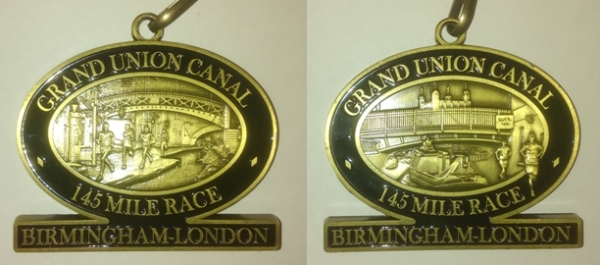
GUCR finishers medal – the start is on one side and the finish is on the other
- There were only 63 finishers! That means that 42 starters (1/3rd of the field) didn’t complete the race! The Grand Union Canal Race is not as easy as it sounds.
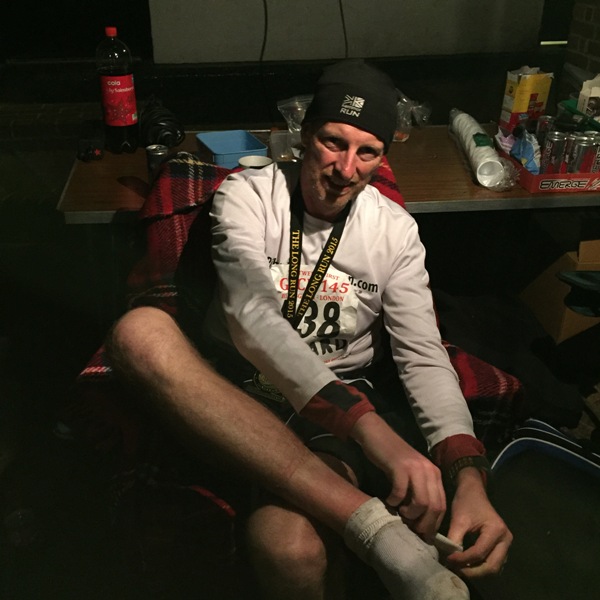
One last photo – About to remove my socks after the finish. My feet weren’t too bad.

